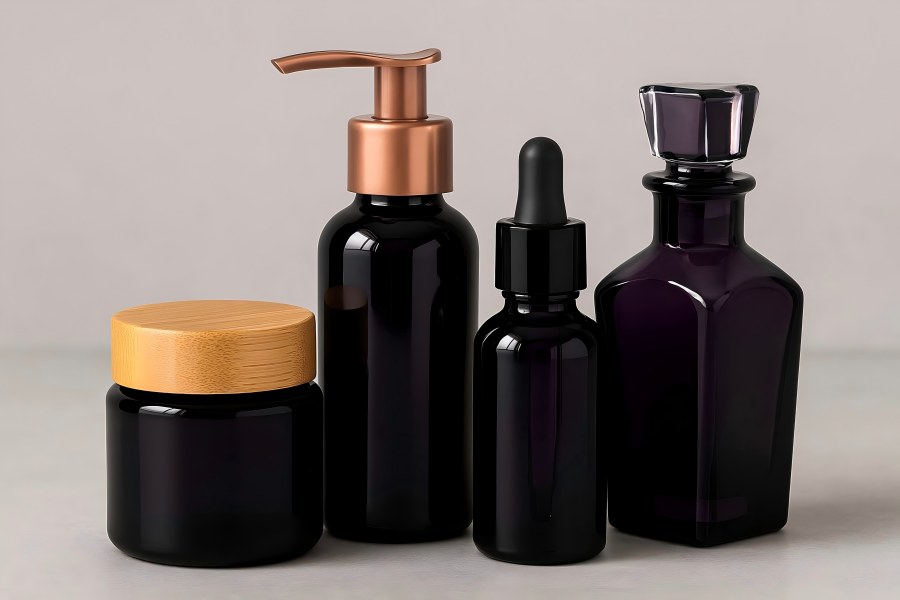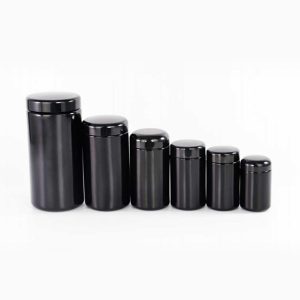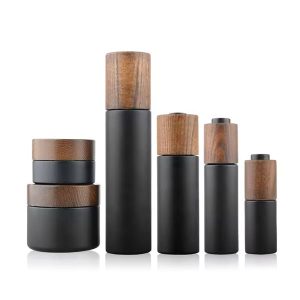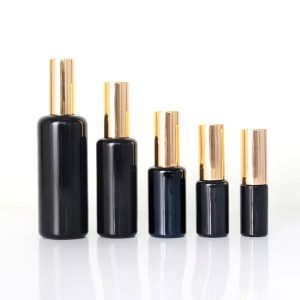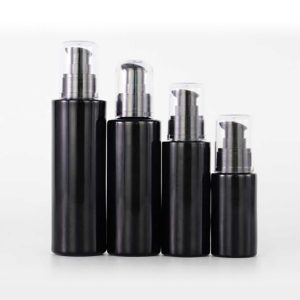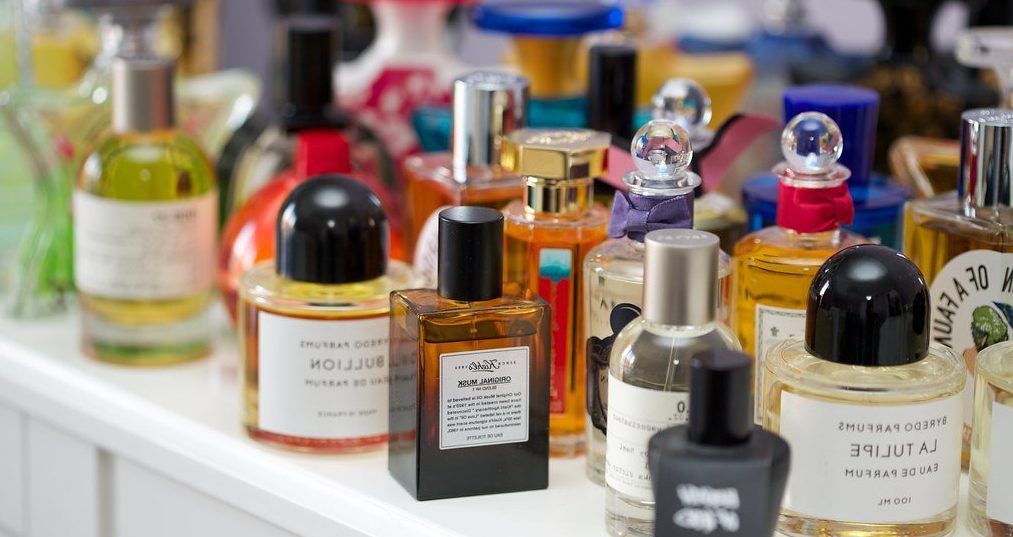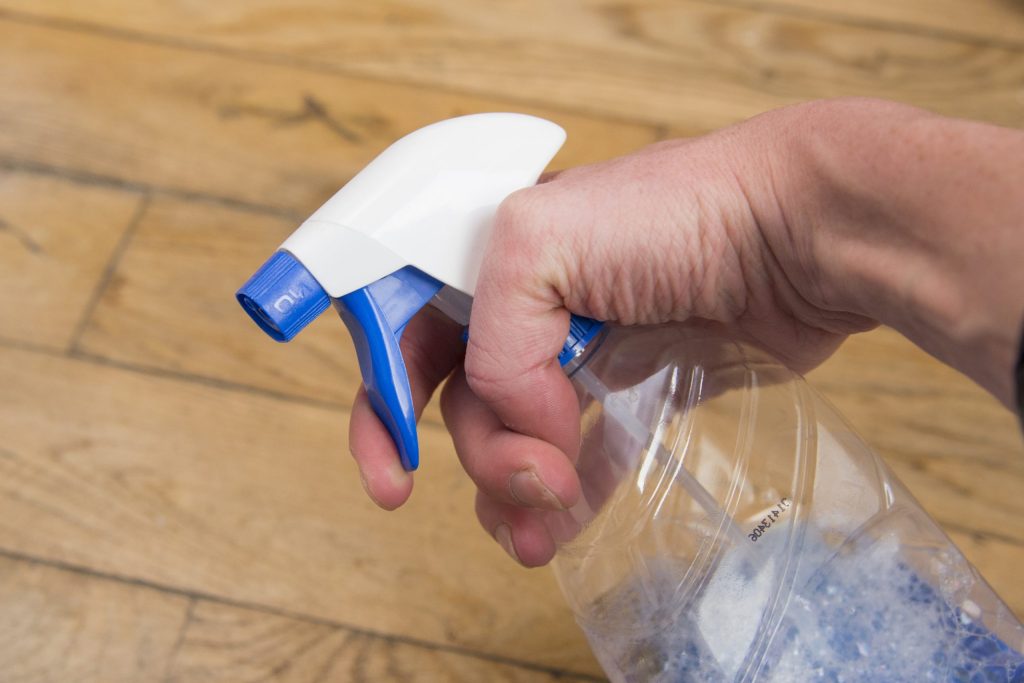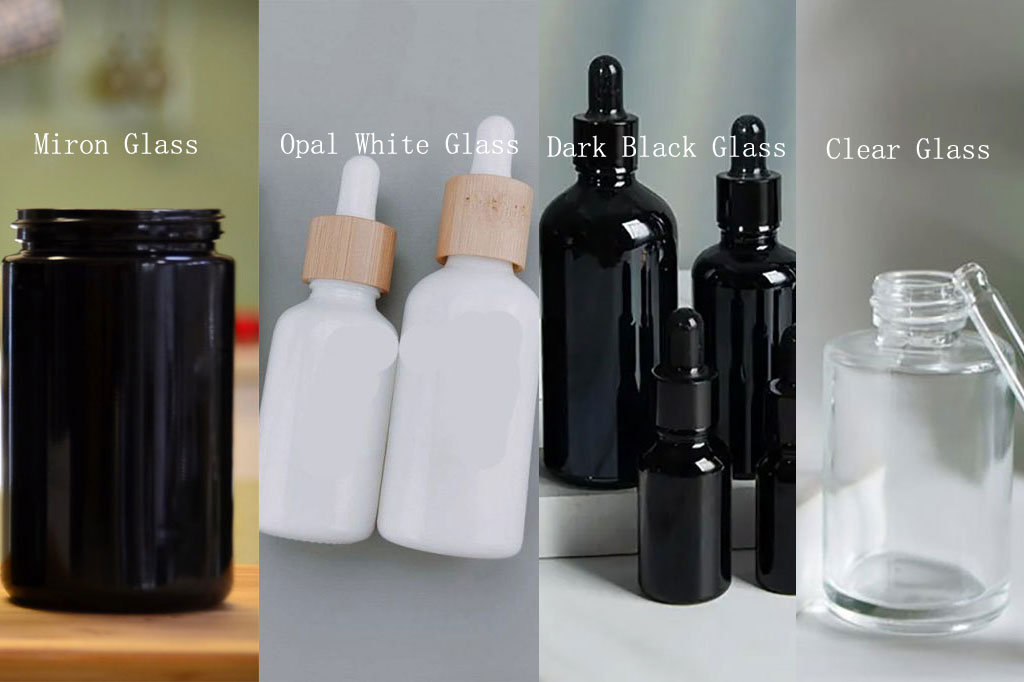In today’s beauty, wellness, and nutraceutical markets, packaging has evolved from simple protection to a strategic branding tool. Dark violet glass stands out among premium materials for its blend of aesthetic elegance and superior preservation. Its true strength lies in customization—through bottle shapes, cap styles, surface finishes, and printing techniques that turn packaging into a direct expression of brand identity.
This article explores how these design, material, and decoration options elevate both function and form.
Why Dark Violet Glass Stands Out
Dark violet glass—sometimes referred to as Miron or biophotonic glass—is renowned for its ability to filter light in a way that protects contents from UV degradation while allowing beneficial infrared and visible violet wavelengths to pass through. This selective light transmission helps preserve natural products such as essential oils, serums, and herbal tinctures by slowing molecular decay and extending shelf life.
Beyond protection, dark violet glass carries emotional and visual appeal. The deep hue communicates luxury, purity, and scientific credibility. Consumers associate violet tones with creativity, spirituality, and sophistication—qualities that align with premium wellness and skincare brands.
However, not all dark violet bottles are created equal. The degree of customization—from the contour of the glass to the tactile feel of the closure—determines how the packaging resonates with the end user.
Custom Bottle Shapes
Standard vs. Custom-Mold Designs
Manufacturers typically offer a range of standard molds for dark violet glass bottles, including cylindrical, square, round-shouldered, and Boston round profiles. These molds provide quick turnaround and lower production costs for brands launching smaller product lines.
Custom molds, however, open up virtually limitless possibilities. A bespoke bottle shape can communicate the brand story instantly—sleek lines for modern minimalism, organic curves for botanical authenticity, or faceted geometries for avant-garde elegance. For example, a skincare brand focusing on clinical-grade formulations might opt for a tall, lab-style cylinder, while a luxury aromatherapy line may prefer a softer, pebble-like silhouette.
Functional Shape Considerations
Shape also affects usability and shelf presence.
- Ergonomic handling: Bottles with slightly indented grips or flattened sides improve user comfort and reduce slippage during dispensing.
- Storage efficiency: Square or rectangular bases maximize shelf space in retail displays and shipping cartons.
- Dosage and viscosity control: Taller necks accommodate pumps or droppers for serums, while wide-mouth jars suit creams and balms.
- Product line consistency: Creating a modular design language—consistent shoulders, neck diameters, and base styles—helps consumers visually connect different SKUs within a product line.
Decorative Geometry and Finishes
Dark violet glass bottle supports advanced shaping techniques that combine functionality with ornamentation. Designers can integrate embossed brand marks, etched grip zones, or geometric ridges directly into the mold. Some brands experiment with frosted finishes, faceted panels, or wave textures that play with light reflection across the deep purple surface.
Custom-shaped glass also interacts differently with the product’s color or viscosity. Transparent serums may glow subtly through the violet tint, while opaque creams appear dramatic and mysterious. Each shape influences the way light refracts inside the bottle—adding depth and intrigue to shelf presentation.
Choosing the Right Cap or Closure
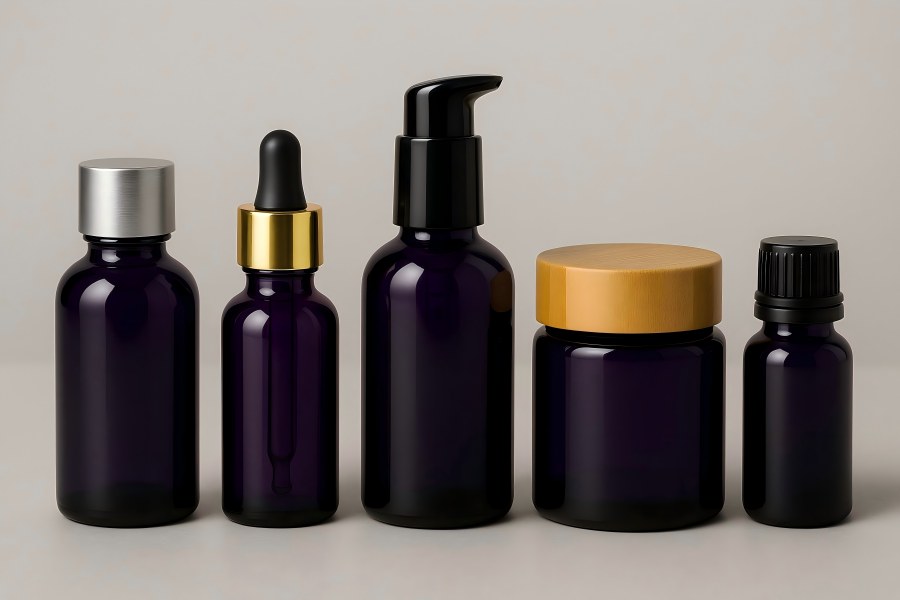
Caps and closures serve both practical and branding roles—they protect the formulation, control dosage, and complete the bottle’s visual composition. With dark violet glass, the closure design can emphasize contrast or reinforce unity through coordinated color and material choices.
Common Closure Types
Screw Caps:
These are the most ubiquitous closures, ideal for oils, toners, and supplements. They can be made of aluminum, PP (polypropylene), or glass. Brushed aluminum screw caps pair particularly well with dark violet glass, lending a modern metallic contrast.
Droppers and Pipettes:
For serums, tinctures, or concentrated essences, droppers ensure precise dosing. Customization includes the bulb material (silicone or TPE), pipette length, and collar finish. Gold-plated or matte black collars create striking accents against violet glass.
Pumps and Sprayers:
Dispensing systems such as lotion pumps, mist sprayers, and airless pumps are common in skincare and aromatherapy packaging. Airless pumps protect oxygen-sensitive formulas, while fine-mist sprayers offer elegant diffusion for fragrances.
Screw-Top Jars and Wide-Mouth Closures:
Used primarily for creams, balms, or capsules, these closures can include inner seals for freshness. Wooden lids or bamboo accents enhance the eco-luxury feel when paired with violet glass jars.
Tamper-Evident and Child-Resistant Caps:
In pharmaceutical and nutraceutical sectors, compliance with safety standards is vital. Violet glass containers can be fitted with specialized tamper bands or CR closures without compromising visual appeal.
Materials and Finishes
Caps can be made from aluminum, steel, glass, PCR plastic, bamboo, or composite materials. Each conveys a different tactile and emotional experience:
| Cap Material | Visual Effect | Typical Use |
| Aluminum (brushed or anodized) | Sleek, modern, metallic | Premium skincare, perfumes |
| Bamboo/Wood | Natural, eco-conscious | Organic and sustainable brands |
| Plastic (PP/ABS) | Versatile, cost-effective | Mass-market cosmetics |
| Glass | Seamless unity with bottle | High-end fragrance or oil blends |
| Metal-plastic hybrid | Functional durability | Lotion or pump dispensers |
Surface finishes can be matte, glossy, anodized, or painted to complement the dark violet hue. Some brands introduce gradient metallic coatings (rose gold, gunmetal, or champagne tones) to create a luxury aesthetic.
Design Harmony
The key to premium packaging is harmony. A minimalist cylindrical bottle may pair best with a flat aluminum cap, while an ornate bottle benefits from a sculpted cap. Maintaining consistent visual proportions between bottle height and closure diameter ensures balanced aesthetics.
For product families, cap customization can also create visual differentiation between categories—silver for day serums, gold for night treatments, or natural bamboo for organic variants.
Printing and Decoration Techniques
Printing and decoration transform plain glass into a brand statement. On a dark violet glass bottle, the challenge lies in balancing readability, adhesion, and contrast while preserving the material’s elegance. The following techniques offer diverse aesthetic and tactile results.
Screen Printing (Silk-Screen Printing)
Screen printing remains the most common and durable decoration technique for glass bottles. Using a fine-mesh stencil, ink is pushed into the bottle’s surface.
For violet glass, opaque white, metallic gold, or silver inks provide the best contrast. UV-curable inks ensure vibrant, scratch-resistant finishes suitable for daily handling and cosmetic exposure.
Screen printing allows fine lines, logos, and text to be applied with precision. Multi-layer printing can create raised textures or 3D embossing effects, giving tactile interest to minimalist designs.
Hot Stamping (Foil Printing)
Hot stamping transfers metallic foil onto the glass under heat and pressure, creating reflective accents. Gold, silver, or holographic foils are often used to highlight logos, frames, or product names.
When paired with dark violet glass, foil stamping produces luxury contrasts—light glints against deep color, evoking premium craftsmanship. Many perfume and skincare brands rely on this technique for limited-edition or prestige lines.
UV Digital Printing
Full-color images may be printed directly onto curved surfaces using UV digital printing and inkjet technology. It’s ideal for short runs, seasonal packaging, or personalization campaigns (such as limited-name editions).
Unlike screen printing, which requires separate screens per color, UV printing can reproduce gradients, photo-quality imagery, and variable data without tooling costs. On dark violet glass, high-opacity inks or white underlays ensure crisp visibility.
Acid Etching and Frosting
Acid etching produces a matte, frosted finish by chemically roughening the glass surface. The result feels velvety and soft to touch, reducing glare and adding grip.
Etched designs can cover the entire bottle or form selective patterns such as translucent windows revealing the product inside. Frosted violet glass also mutes reflections, creating a more understated, artistic appearance.
Decals and Transfers
Decal printing allows intricate, multicolor artwork to be pre-printed on a special carrier and later fused onto the glass at high temperature. This method offers museum-grade detail suitable for heritage branding or complex illustrations.
Because decals require firing, they become part of the glass surface—extremely durable and resistant to solvents. On violet glass, they produce a vintage or artisanal aesthetic, often used by apothecary or botanical brands.
Embossing and Debossing
Embossing (raised relief) or debossing (recessed impressions) can be integrated into the mold itself. Unlike printing, this technique permanently alters the glass structure.
An embossed logo or pattern enhances authenticity and prevents counterfeiting, while offering tactile cues for consumers. When light passes across embossed violet glass, subtle highlights and shadows reinforce depth and craftsmanship.
Combining Techniques for Signature Effects
Truly standout packaging often results from combining multiple decoration methods. For instance:
- Luxury and minimalism are balanced by a frosted body with hot-stamped gold accents.
- Screen-printed text over an embossed emblem adds texture and legibility.
- Digital-print illustrations paired with a matte bamboo cap create eco-chic harmony.
The interplay between color, gloss, and texture is especially striking on violet glass. Because the glass itself carries a rich hue, designers can minimize print coverage to let the natural beauty of the material shine through—this approach aligns with sustainability goals by reducing ink use and processing steps.
Branding Strategy
Customization should always align with the brand’s target market and value proposition. The following segmentation demonstrates how different combinations of shape, cap, and printing create distinct brand personalities:
| Market Segment | Shape Style | Cap Type | Printing/Finish | Brand Message |
| Luxury Skincare | Sleek cylindrical, heavy base | Gold aluminum pump | Hot-stamped metallic foil | Prestige, sophistication |
| Organic Beauty | Rounded jar, natural curves | Bamboo lid | Minimal screen print in white | Eco-conscious, pure |
| Aromatherapy | Boston round dropper bottle | Black pipette | Gold logo embossing | Natural yet elegant |
| Pharmaceutical/Nutraceutical | Square-shouldered or vial | Child-resistant cap | White or silver text | Trustworthy, clinical |
| Boutique Perfume | Faceted flask | Custom sculpted glass cap | Laser engraving | Artistic, exclusive |
Customization becomes a storytelling tool: it signals not just what the product is, but who the brand is.
For example, a violet glass serum bottle with a precision dropper and gold foil logo evokes exclusivity and precision, while a matte violet jar with a bamboo lid suggests sustainability and serenity. Every tactile and visual detail communicates an emotion before the user even opens the cap.
Manufacturing Considerations for Custom Violet Glass
Mold Creation and Minimum Orders
Custom bottle shapes require investment in mold tooling. A new mold may cost tens of thousands to several thousand dollars, depending on its intricacy. Manufacturers frequently impose minimum order quantities (MOQ) on custom designs, usually ranging from 10,000 to 50,000 units.
For smaller brands, semi-custom options (modifying an existing mold with a unique closure or decoration) can provide a cost-effective compromise.
Color Consistency and Quality Control
Producing uniform violet glass requires precise control of manganese oxide content and furnace conditions. Reputable manufacturers test each batch for consistent optical density, transparency, and mechanical strength. Brands should also check the compatibility of closures and printing inks under UV exposure and temperature fluctuations.
Sustainability and Recycling
While dark violet glass bottle is fully recyclable, its deep hue may limit acceptance in some local recycling streams. However, many brands offset this by promoting reusable packaging—encouraging customers to refill or repurpose violet bottles. Pairing violet glass with sustainable closures like bamboo or aluminum further reinforces eco-friendly messaging.
Lead Times and Production Planning
Custom manufacturing generally requires 8–16 weeks, depending on mold complexity, decoration steps, and shipping. Brands planning seasonal launches or limited editions should account for these lead times. Digital printing and semi-custom decoration options offer flexibility for faster rollouts.
The Psychology of Dark Violet in Packaging
Color psychology plays a crucial role in how consumers perceive products. Violet is often associated with mystery, wisdom, and transformation, making it ideal for brands promoting wellness, luxury, or holistic healing.
Dark violet glass bottle, specifically, combines the calm of blue and the energy of red, producing an impression of balance and refinement. Its visual depth suggests both natural integrity and scientific credibility—qualities that attract discerning customers in skincare and health markets.
Customization amplifies this psychology: gold foil adds royal prestige, white print conveys purity, and matte caps soften the tone toward tranquility. Understanding these nuances allows brands to design packaging that resonates emotionally while staying consistent with their product philosophy.
Case-Inspired Concepts
To illustrate the potential of customization, consider three hypothetical product lines:
A. “Aurora Botanicals” Essential Oils
- Bottle: 30 ml dark violet dropper bottle with embossed logo
- Cap: Matte black pipette with soft-touch bulb
- Print: Minimal gold hot-stamped logo
- Effect: Luxurious yet natural, highlighting purity and craftsmanship
B. “Lunaris Skincare” Night Serum
- Bottle: Custom elongated silhouette with thick base
- Cap: Anodized rose-gold pump
- Print: White UV ink with gradient moon motif
- Effect: Elegant, feminine, and celestial—aligning with nighttime repair theme
C. “VitaCore Nutrition” Herbal Supplements
- Bottle: Wide-mouth violet glass jar
- Cap: Child-resistant matte aluminum lid
- Print: Screen-printed silver text with subtle embossed crosshatch texture
- Effect: Scientific, credible, and professional, ideal for retail pharmacies
These examples show how the interplay of shape, cap, and decoration tailors violet glass to entirely different consumer expectations.
Future Trends in Violet Glass Bottle Customization
As packaging technology evolves, so do customization options for dark violet glass:
- Smart labeling: Integrating NFC chips or QR codes into printed designs for authenticity verification and storytelling.
- Laser engraving: Permanent, chemical-free branding ideal for eco-friendly production.
- Gradient coatings: Iridescent finishes transitioning from violet to black or gold.
- Hybrid materials: Combining violet glass with recycled aluminum collars for sustainable luxury.
- Refill systems: Threaded pump modules enabling long-term reuse of high-quality violet bottles.
Brands increasingly view packaging not just as a container, but as part of the product experience—a reusable object that reflects innovation and responsibility.

